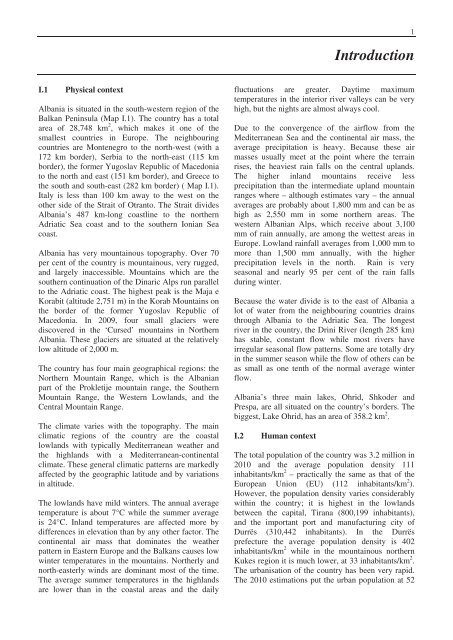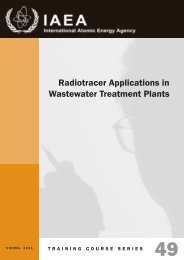Second Environmental Performance Review of Albania
Second Environmental Performance Review of Albania
Second Environmental Performance Review of Albania
Create successful ePaper yourself
Turn your PDF publications into a flip-book with our unique Google optimized e-Paper software.
1Introduction I.1 Physical context<strong>Albania</strong> is situated in the south-western region <strong>of</strong> theBalkan Peninsula (Map I.1). The country has a totalarea <strong>of</strong> 28,748 km 2 , which makes it one <strong>of</strong> thesmallest countries in Europe. The neighbouringcountries are Montenegro to the north-west (with a172 km border), Serbia to the north-east (115 kmborder), the former Yugoslav Republic <strong>of</strong> Macedoniato the north and east (151 km border), and Greece tothe south and south-east (282 km border) ( Map I.1).Italy is less than 100 km away to the west on theother side <strong>of</strong> the Strait <strong>of</strong> Otranto. The Strait divides<strong>Albania</strong>’s 487 km-long coastline to the northernAdriatic Sea coast and to the southern Ionian Seacoast.<strong>Albania</strong> has very mountainous topography. Over 70per cent <strong>of</strong> the country is mountainous, very rugged,and largely inaccessible. Mountains which are thesouthern continuation <strong>of</strong> the Dinaric Alps run parallelto the Adriatic coast. The highest peak is the Maja eKorabit (altitude 2,751 m) in the Korab Mountains onthe border <strong>of</strong> the former Yugoslav Republic <strong>of</strong>Macedonia. In 2009, four small glaciers werediscovered in the ‘Cursed’ mountains in Northern<strong>Albania</strong>. These glaciers are situated at the relativelylow altitude <strong>of</strong> 2,000 m.The country has four main geographical regions: theNorthern Mountain Range, which is the <strong>Albania</strong>npart <strong>of</strong> the Prokletije mountain range, the SouthernMountain Range, the Western Lowlands, and theCentral Mountain Range.The climate varies with the topography. The mainclimatic regions <strong>of</strong> the country are the coastallowlands with typically Mediterranean weather andthe highlands with a Mediterranean-continentalclimate. These general climatic patterns are markedlyaffected by the geographic latitude and by variationsin altitude.The lowlands have mild winters. The annual averagetemperature is about 7°C while the summer averageis 24°C. Inland temperatures are affected more bydifferences in elevation than by any other factor. Thecontinental air mass that dominates the weatherpattern in Eastern Europe and the Balkans causes lowwinter temperatures in the mountains. Northerly andnorth-easterly winds are dominant most <strong>of</strong> the time.The average summer temperatures in the highlandsare lower than in the coastal areas and the dailyfluctuations are greater. Daytime maximumtemperatures in the interior river valleys can be veryhigh, but the nights are almost always cool.Due to the convergence <strong>of</strong> the airflow from theMediterranean Sea and the continental air mass, theaverage precipitation is heavy. Because these airmasses usually meet at the point where the terrainrises, the heaviest rain falls on the central uplands.The higher inland mountains receive lessprecipitation than the intermediate upland mountainranges where – although estimates vary – the annualaverages are probably about 1,800 mm and can be ashigh as 2,550 mm in some northern areas. Thewestern <strong>Albania</strong>n Alps, which receive about 3,100mm <strong>of</strong> rain annually, are among the wettest areas inEurope. Lowland rainfall averages from 1,000 mm tomore than 1,500 mm annually, with the higherprecipitation levels in the north. Rain is veryseasonal and nearly 95 per cent <strong>of</strong> the rain fallsduring winter.Because the water divide is to the east <strong>of</strong> <strong>Albania</strong> alot <strong>of</strong> water from the neighbouring countries drainsthrough <strong>Albania</strong> to the Adriatic Sea. The longestriver in the country, the Drini River (length 285 km)has stable, constant flow while most rivers haveirregular seasonal flow patterns. Some are totally dryin the summer season while the flow <strong>of</strong> others can beas small as one tenth <strong>of</strong> the normal average winterflow.<strong>Albania</strong>’s three main lakes, Ohrid, Shkoder andPrespa, are all situated on the country’s borders. Thebiggest, Lake Ohrid, has an area <strong>of</strong> 358.2 km 2 .I.2 Human contextThe total population <strong>of</strong> the country was 3.2 million in2010 and the average population density 111inhabitants/km 2 – practically the same as that <strong>of</strong> theEuropean Union (EU) (112 inhabitants/km 2 ).However, the population density varies considerablywithin the country; it is highest in the lowlandsbetween the capital, Tirana (800,199 inhabitants),and the important port and manufacturing city <strong>of</strong>Durrës (310,442 inhabitants). In the Durrësprefecture the average population density is 402inhabitants/km 2 while in the mountainous northernKukes region it is much lower, at 33 inhabitants/km 2 .The urbanisation <strong>of</strong> the country has been very rapid.The 2010 estimations put the urban population at 52
















